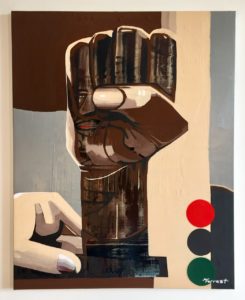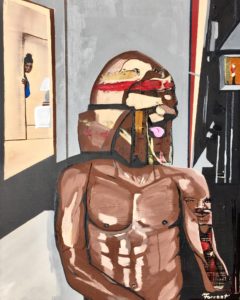Forrest Kirk has spent the last fourteen years abstracting police brutality. His first major solo exhibition, Body Count (2018) at Chimento Contemporary, put him on the map for its stark, colorful portrayal of the cop psyche — how armed guards of the state disguise themselves as servants of the people when convenient. It might seem that Kirk was ahead of his time all along, but to that, he responds, “Ever heard of the Watts Riots?”
Born in San Diego and based in Los Angeles, the painter interweaves the long history of police violence on Black Americans with the complex brilliance of abstract expressionism in his work. He sat down to discuss the responses to those paintings then and now, the effects of the pandemic and nationwide uprising on his art, and what he’s been working on lately. —Billy Anania

How and when did you first begin working on the Body Count series, and what was your process?
Body Count is really a lifetime of experiences in one body of work. It started with Rodney King and other police-driven incidents in the ‘80s and ‘90s, growing up in California with the experience of police brutality at my own hands and those of my friends. When I started painting narrative police works back in 2006, I did this series of cop cars burning and then another with officers as samurai soldiers; instead of swords, however, they had billy clubs. That was my first foray in taking over that identity. Then, as with many other things, I paint a series, leave it for a while, and circumstances change. I might be in love and make paintings about love, and then meander back over time.
In 2017, following another string of young Black men gunned down by police, I went through a period of intense anger. Every time I’d set to work, I would literally cuss at the canvas, like, “These motherfuckers are gonna get it!” I was so upset. This was while working on two series of paintings called Police Academy 1 & 2, with officers depicted as robots. I realized these police officers are part of this mindset in which, once they cross a certain line, they are no longer policing by definition. They become a demonic force. That, to me, is the essence of the issue. There’s legitimate work, if someone harms you and you want protection, but there’s another level of crossing the line. That’s what Body Count is all about, teetering that line. One painting called “Paranoia Gland,” an autopsy of the police mind and brain, examines this ability to cross the line into non-police work, into this demonic work.
Your work shifts between mysticism and abstract expressionism, and there’s so much happening in each piece. Who are your major painting inspirations?
For me, there are the living legends and the ancestors. For the former, that’s Kerry James Marshall and Gerhard Richter. Richter’s abstractions are so detailed and seemingly flawless, you know? And then with Marshall, I love his narrative works using the Black figure. Some other inspirations are Jean-Michel Basquiat, Roy Lichtenstein, Willem de Kooning, Marcel Duchamp, Nina Chanel Abney, and Alice Neal. The list goes on and on, but first and foremost it’s always Richter and Marshall.
You have a very versatile painting style, just like Richter. You could paint something really far out and abstract, then switch to something hyperreal. What was the initial reception to Body Count? What kind of responses did you get?
I got a lot of critical writing about it, from the LA Times, and several other magazines internationally. It was my first big solo show, but it still got press from Sweden, Scandinavia, and some of the biggest artists in the world are now purchasing my work because of it. I am in complete disbelief when artists from Gagosian or Hauser & Wirth inquire about my paintings.
I was in another show called Protest at Torrance Art Museum in 2019, and some lieutenant from the LAPD asked if the force could display some of those works at one of their precincts, which totally blew me away. Here we are in 2020 with George Floyd and Breonna Taylor, these horrific things happening to beautiful souls, then there’s these cops trying to be Officer Friendly, saying, “Oh, I’m sorry that happened!” Their attempts to display my paintings were kind of the same thing but around the time of Trayvon Martin and Walter Scott. Rather than face responsibility, remove qualified immunity or face jail time, cops would rather be Officer Friendly and reach out with these piecemeal gestures that do not mean anything. That’s why I didn’t think it was a good idea, and we didn’t go through with it.

Thinking about the way the art market functions, especially as an artist painting police brutality, it’s probably easy to be critical of the opportunists and profiteers. It’s interesting to see how artists who depict police violence are integrated into the industry and how the public responds to that.
I would be remiss if I did not mention one thing that made the paintings resonate more so than others. With Body Count, I think it struck people not only because the paintings were made to be aesthetically pleasing, with lots of colors, but none of them actually have anybody getting shot. There isn’t any actual physical violence, if you notice. I think this is why it hit so hard, because it was not “didactic” — I wasn’t trying to make you see something I saw.
I have a painting called “The Right Tool for the Job” that shows an officer’s torso. Coming through his chest is a tricycle, and in his holster a water gun. You think about the tricycle and squirt gun, that they must have to do with childhood, then you think of the juxtaposition with police. There are certain symbols in there that lead you to draw your own conclusions. Each of these paintings is like that, symbols that elicit the thought of police brutality where they might cross the line, but never a specific image of them crossing the line.
I hadn’t thought about that, that there’s no actual point of contact in any of them.
Right, but your mind leads you there, and I think that’s what resonated most.
As far as recent paintings, what kind of work have you been doing since 2018?
I did a series in 2019 around the Black figure and different ways to portray it. I also displayed some work in a group show at the Roberts Project, Behind Face, and one of those paintings ended up on a CBS television show called The Good Fight.
As of late, I’ve been working on a series of fists. I had a show called Nine Fists at Parrasch Heijnen Gallery here in LA. It was literally nine paintings of fists — mostly figurative with some abstraction — based on the 1968 Olympics. With the movement we have now, BLM and ACAB as well as society’s tolerance in general, it is an evergreen series. It’s setting me off on a trajectory to do more fists, so that’s what I’ve been doing lately.
I have this vision of creating many more fists and bringing them all together one day. I would love to have an exhibition that accumulates 30 or 40 of them all in one place. They’re very powerful all together, because they are almost like our current movement. When people are out there protesting, everyone is putting up the fist, but each person has their own reason. One might have had a brother killed by police. One might just want human rights for everyone, while someone else is there just because they think police are overstepping their bounds and they want to defund police. But they are all the same gesture, so it’s kind of like a collective versus individual struggle.
As an artist, how have you been managing in quarantine with all the delays and exhibition cancellations?
I’ve been using the quarantine as best I can, with much more time to develop paintings. There are so many paintings I’ve been meaning to do for a long time but put on hold. As far as cancellations, it sucks to miss the Dallas Art Fair and solo shows in New York, but at the same time, that needs to happen for everyone’s safety. Art is obviously important, but people’s lives are more important, and there are 30 million people out of work. For me, it’s just about being sensitive to that, continuing to make work, continuing to get better, continuing toward my goal of becoming the best painter in the world, but at the same time recognizing that we are in the midst of a global pandemic and this is something that the entire world is facing. While we go through this, artists can make the best of it by pushing and taking risks with their work to make sure that each piece is fully realized.



